Most Americans alive today don’t remember a time before marijuana prohibition. During their lifetimes, the media and mainstream culture has linked marijuana with criminal activity and addiction. Even when tourists visit a cannabis dispensary in a state where recreational marijuana is legal, they don’t associate purchasing a joint with something as normal as getting a glass of wine at a bar. Marijuana has been illegal and stigmatized for so long in much of the country that even when they’re not breaking any laws, people often still feel as though they’re doing something forbidden when they consume it.
Why is marijuana illegal today? How did marijuana criminalization begin? The answer to these questions doesn’t begin with marijuana – it starts with industrial hemp.
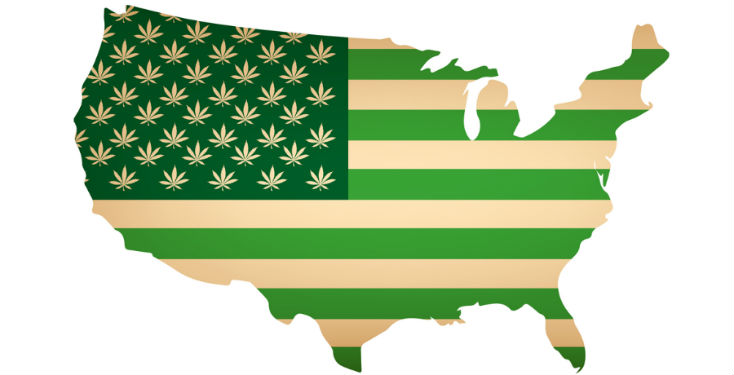
How did marijuana become illegal in the U.S.?
Cannabis Prohibition Targets Hemp
Hemp is a non-psychoactive form of cannabis which contains practically nonexistent levels of THC, the ingredient responsible for marijuana getting people high. While it can’t cause a high, it has a wide variety of uses. Industrial hemp can be used for everything from paper and clothing manufacturing to construction and food products.
When the U.S. was first colonized, industrial hemp was an important cash crop. In fact, King James I ordered that each colonist grow 100 hemp plants to be used for fiber exports. If a farmer refused to grow hemp, they could be fined or even jailed. Even George Washington, the very first U.S. president, was a hemp enthusiast, growing it at his plantation. Next to lumber and tobacco, hemp was the most popular cash crop in the U.S.
What does non-psychoactive hemp have to do with psychoactive marijuana prohibition? One of the most popular theories about the history of marijuana prohibition is that it all began due to the power of corporate interests.
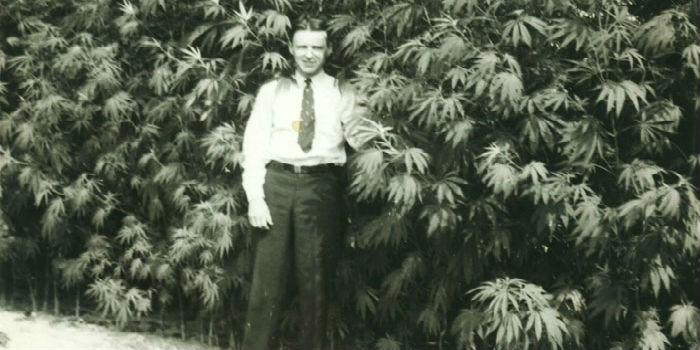
Before marijuana prohibition, hemp was an important cash crop in the U.S.
Competition with Paper and Nylon
In the early 19th century, the U.S. pulp and paper industry was booming. It needed a steady supply of trees in order to provide the raw materials to make enough paper to keep the ever-growing industry running.
The Hearst Empire
William Randolph Hearst was best known as a newspaper mogul whose empire stretched from coast to coast. Hearst newspapers popularized “yellow journalism”—a tabloid style of news reporting that was exaggerated, crude, and sensationalistic. Readers lined up to hear the latest stories about crime, corrupt public figures, and sex scandals.
Although experts on marijuana information and history argue about the truth behind the story, many believe that Hearst had a significant investment in the timber industry. Because hemp is quick-growing and can be used to make high-quality paper products, it posed a real threat to the wood and pulp industry. Naturally, Hearst would have been enthusiastic about eliminating any competition in the race for raw paper materials. In other words, cannabis prohibition would have removed one of Hearst’s growing sources of competition.
The Du Pont Company
Another player in the war against hemp? The Du Pont company, which had recently patented a new substance called nylon. They had also discovered a new process of using wood pulp to manufacture paper. Du Pont feared that in addition to being an easy source of high-quality paper, hemp could also be used as a substitute for nylon.
Powerful individuals have friends in high places, and Hearst and the Du Ponts were no exception. They enlisted the help of Andrew Mellon, the Secretary of the Treasury. Mellon was also heavily invested in the Du Pont company.
In addition to being a potentially huge competitor to the wood pulp industry and nylon, hemp also posed a threat to the oil and gas industry. After it became clear that ethanol could serve as a replacement for standard gasoline, a law enacting a prohibition on alcohol was passed in 1919. When Ford Motor Company discovered a way to extract ethanol from hemp, the oil industry had a new enemy. A push began to make hemp and marijuana illegal in order to eliminate all potential competition.
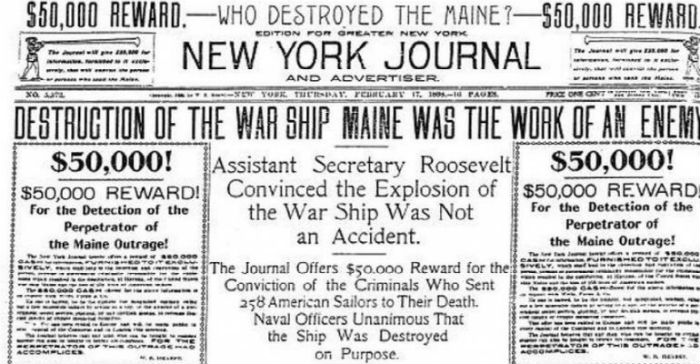
An example of “yellow journalism” from a Hearst newspaper in the days before cannabis prohibition.
Racism in the Race for Marijuana Prohibition
The American public was largely unconcerned with corporate profits and competition. What did motivate them, as Hearst knew from his over-the-top headlines, was sensationalism and fear. In order to move public opinion against the hemp form of cannabis, it was necessary to make it inseparable from psychoactive marijuana and connect the latter to something that Hearst knew people would regard with suspicion: racial minorities and specifically— Mexican immigrants.
This was no stretch for Hearst, who held racist views. He quickly began using his newspapers to print stories that connected the psychoactive form of cannabis to racial minorities. In this way, he was able to push public opinion in favor of the prohibition of marijuana.
So began a particularly ugly chapter in marijuana prohibition history. A sample from one of Hearst’s columns reads: “Was it marijuana, the new Mexican drug, that nerved the murderous arm of Clara Phillips when she hammered out her victim’s life in Los Angeles?… THREE-FOURTHS OF THE CRIMES of violence in this country today are committed by DOPE SLAVES — that is a matter of cold record.”
In another article, one of Hearst’s papers proclaimed: “The fatal marihuana cigarette must be recognized as a DEADLY DRUG, and American children must be PROTECTED AGAINST IT.”
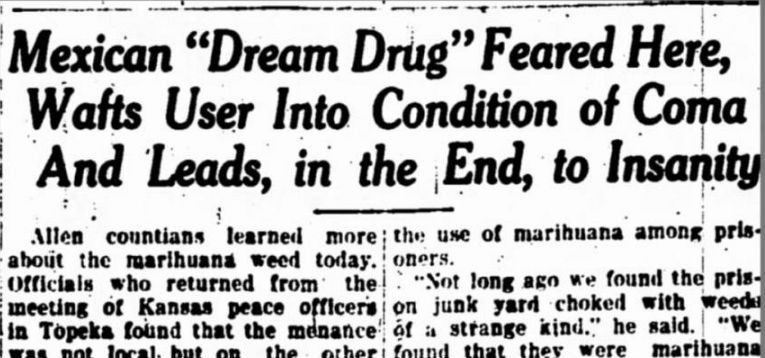
Hearst newspapers advocated for marijuana prohibition by warning that it was a “deadly drug” that posed a risk to American children.
In 1932, Federal Bureau of Narcotics was formed, headed by Harry Anslinger, Mellon’s nephew. Although cannabis was not a narcotic, Anslinger helped lead the campaign against it, popularizing the Mexican Spanish name for the substance—“marihuana.” This painted cannabis as foreign and dangerously exotic, making it seem as though the criminalization of marijuana was necessary to keep the country safe.
The racist, anti-immigrant push for marijuana prohibition quickly spread across the country. Resentment towards Mexican immigrants who were perceived as stealing American jobs fueled the fire. Here are a few excerpts from letters and articles published by local newspapers during this time:
“Marijuana, perhaps now the most insidious of our narcotics, is a direct by-product of unrestricted Mexican immigration . . . . Mexican peddlers have been caught distributing sample marijuana cigarettes to school children.” —the New York Times, a 1935 letter to the editor
“I wish I could show you what a small marijuana cigaret can do to one of our degenerate Spanish-speaking residents. That’s why our problem is so great; the greatest percentage of our population is composed of Spanish-speaking persons, most of whom are low mentally, because of social and racial conditions.” —a letter to Anslinger from a Colorado newspaper editor
“Marihuana influences Negroes to look at white people in the eye, step on white men’s shadows and look at a white woman twice.” —from a newspaper in 1934
Racist and fear-mongering views about marijuana weren’t limited to writing in local newspapers. One Texas senator said while speaking on the floor of the state Senate: “All Mexicans are crazy, and this stuff [marijuana] is what makes them crazy.” In time, marijuana had been inexorably linked with racial minorities, jazz and swing music, sexual debauchery, as well as unpredictable and violent behavior.
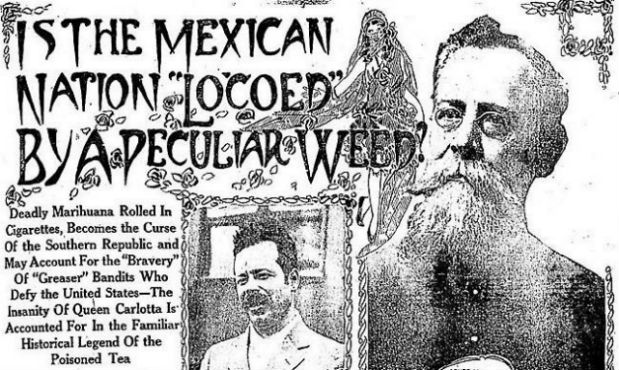
The push for marijuana criminalization was partially fueled by a backlash against Mexican immigrants.
Reefer Madness Is Born
Anyone wondering “Why is cannabis illegal?” in today’s world need only look to the furor that snowballed throughout the 1930s. Even some members of the medical community got on board with stoking cannabis fears. In 1931, Dr. A. E. Fossier wrote an article for the New Orleans Medical and Surgical Journal. In part, it read: “Under the influence of hashish those fanatics would madly rush at their enemies, and ruthlessly massacre every one within their grasp.”
Dramatic propaganda ads presented marijuana as a “Weed with Roots In HELL” that led to “WEIRD ORGIES,” “WILD PARTIES,” and “UNLEASHED PASSIONS.” Parents were warned that marijuana was “A vicious racket with its arms around your children!”
In 1936, a church group made a film that was originally titled Tell Your Children. In it, high school students try marijuana and pay a high price. Some of the over-the-top results of their descent into “drug-crazed abandon” are hallucinations, insanity, manslaughter, and a hit-and-run accident, to name a few. The film was screened in various areas of the country and also went by the titles Doped Youth, The Burning Question, and Reefer Madness.
Despite its origins as anti-marijuana propaganda film, by the 1970s, Reefer Madness had lost its shock value, becoming a laughable cult classic among cannabis policy reformists. In fact, much of the old anti-marijuana propaganda ads and films seem laughable today when they are separated from the movement’s racist origins.
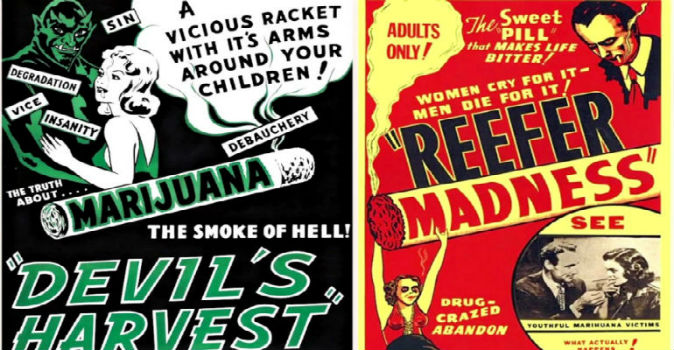
Marijuana criminalization propaganda: anti-marijuana films like “Reefer Madness” represented cannabis as a dangerous and deadly drug.
Marijuana Prohibition and Big Pharma
As early as the 1910s, the criminalization of marijuana was already underway, with individual states passing laws to ban it. This happened due to a wave of alcohol prohibition initiatives that swept cannabis along with them. It also happened because states were concerned over the lack of control and regulation they had over various medicinal concoctions that featured cannabis. During the time, cannabis was used for everything from pain and insomnia to migraines and symptoms of depression.
To see the extent to which marijuana was used as a medical remedy, one need only look at pictures of the ingredient labels of old medicine bottles. One frequently-circulated photo of “One Night” cough syrup shows that it contained a potent combination of alcohol, cannabis indica, chloroform, and morphine.
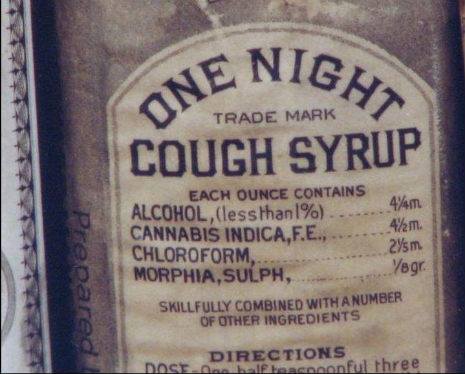
Before marijuana prohibition, cannabis-infused medications were easily found in drugstores.
The Fall of Medical Cannabis
By 1936, 48 states had passed regulations on marijuana. After the passage of the Marijuana Tax Act (which was soon to come in 1937), the number of cannabis prescriptions plummeted. Rather than register with the federal government and pay an annual fee in order to prescribe cannabis, doctors began treating their patients with other drugs.
To fill the medicinal void, pharmaceutical companies developed drugs that worked very well to kill pain. Aspirin and opium-derived drugs such as morphine became the replacement for cannabis in patients who needed pain relief.
So began the pharmaceutical industry’s war against cannabis. To date, they are among the top three industries that lobby against marijuana legalization in the U.S. The other two are the police/prison industry and alcohol manufacturers.
Federal Cannabis Prohibition
One of the most common questions about marijuana prohibition is “When was marijuana made illegal in the U.S.?” While laws passed early on banned it at the state level, it took time for legislation to officially make marijuana illegal throughout the entire country.
The Marijuana Tax Act
While the Marijuana Tax Act of 1937 didn’t ban marijuana outright, it was a carefully-constructed piece of federal legislation that made it much more difficult to legally possess or sell all forms of cannabis in the U.S.
Anslinger pushed hard for the Act, presenting Congress with sensationalistic Hearst articles and stories of bloody rampages that had supposedly happened while the assailant was under the influence of marijuana. After an extremely short set of hearings in which a doctor from the American Medical Association stated its staunch opposition to the Act, Congress voted. The Marijuana Tax Act became law.
Other Federal Legislation
After the Marijuana Tax Act, the federal government continued to strengthen laws cannabis prohibition legislation. In 1951, the Boggs Act established a mandatory minimum sentence of 2 to 5 years for first-time drug offenses. The U.S. went on to include marijuana in the Narcotics Control Act of 1956. This meant that first-time offenders would receive 2 to 10 years in prison and a fine of up to $20,000.
The long list of marijuana prohibition laws continued with the Controlled Substances Act of 1970. It not only criminalized the possession, use, and sale of specific drugs; it also classified marijuana as a Schedule I drug: a substance with “no accepted medical use.” To this day, this classification has prevented scientists from being able to freely research potential medical uses of cannabis.
Before the Controlled Substances Act passed, Congress looked to the Department of Health, Education and Welfare for an opinion about whether or not cannabis should be included. Roger O. Egeberg, the Assistant Secretary for Health and Scientific Affairs replied via letter:
“Since there is still a considerable void in our knowledge of the plant and effects of the active drug contained in it, our recommendation is that marihuana be retained within schedule I at least until the completion of certain studies now underway to resolve the issue. If those studies make it appropriate for the Attorney General to change the placement of marihuana to a different schedule, he may do so in accordance with the authority provided under section 201 of the bill.”
The studies that Egeberg mentioned were concluded in 1972 and recommended completely decriminalizing marijuana. President Richard Nixon refused to do so. (In fact, one of the former president’s top aides later discussed Nixon’s views on marijuana, saying his war on drugs was designed to target hippies and black people – two voting demographics that posed a threat to his presidency.) Three years later, the Drug Enforcement Agency was established for the purpose of combating drug use and possession in the U.S.
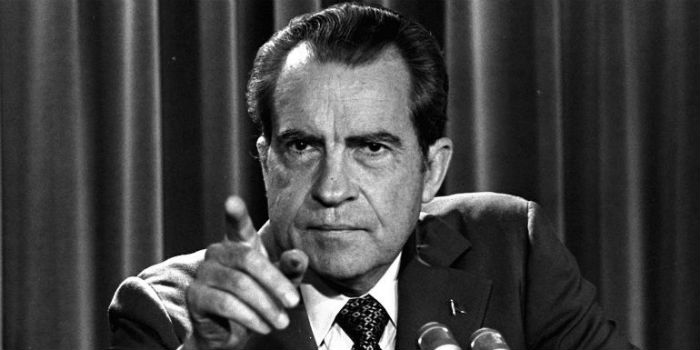
President Richard Nixon felt that the criminalization of marijuana helped target hippies and black people.
Unraveling of Marijuana Prohibition
In the early 20th century, state governments moved to make marijuana illegal long before the U.S. government passed its first anti-cannabis initiative. Given this, it’s really interesting to note that in the late 20th century, state governments have led the charge to decriminalize cannabis. It all started with California’s Compassionate Use Act of 1996, which allowed patients to use cannabis for specific medical conditions such as cancer.
In the years since, other states have followed suit, legalizing cannabis for both medical and recreational purposes. Thirty-three states and the District of Columbia had legalized some form of marijuana by the end of 2018. This puts those states at odds with existing federal law (which still criminalizes all cannabis use and possession). Under President Barack Obama, federal agencies were directed not to focus on enforcement in states that had legalized cannabis. Once Donald Trump entered the White House, those instructions were rescinded, although no major enforcement has been undertaken.
In December of 2018, the U.S. Congress passed a farm bill that officially ended the prohibition on growing industrial hemp. Before that, laws had only been loosened enough to allow for the import and use of raw hemp materials. The updated law declassifies hemp as a controlled substance and removes all federal restrictions on it.
Marijuana Prohibition FAQ
The history of marijuana prohibition is a long and twisting tale, with hemp and marijuana going from cash crop and commonly-used substance to stigmatized and criminalized. Here are some of the questions often raised about marijuana criminalization in the U.S.
Why is marijuana illegal?
There are many theories about the beginnings of marijuana prohibition. One of the most popular ones is that hemp was potential competition to paper and clothing fiber manufacturers and was tied to marijuana in order to be targeted by powerful corporate interests.
When was marijuana made illegal?
The prohibition of marijuana started at the state level first, with some states making marijuana illegal as early as the 1910s. Federal marijuana prohibition started with the Marijuana Tax Act of 1937, with marijuana criminalization beginning in 1956 with the Narcotics Control Act.
When did marijuana become illegal?
The patchwork of cannabis prohibition laws can make it difficult to pinpoint exactly when marijuana became illegal. The Narcotics Control Act of 1956 made marijuana illegal at the federal level; it demanded first-time offenders receive fines of up to $20,000 and 2 to 10 years in prison.
When did marijuana become a schedule I drug?
Marijuana was classified as a Schedule I drug in 1970 as part of the Controlled Substance Act. This category of drugs has “no currently accepted medical use and a high potential for abuse.” In addition to marijuana, it includes heroin, ecstasy, methaqualone, LSD, and peyote.
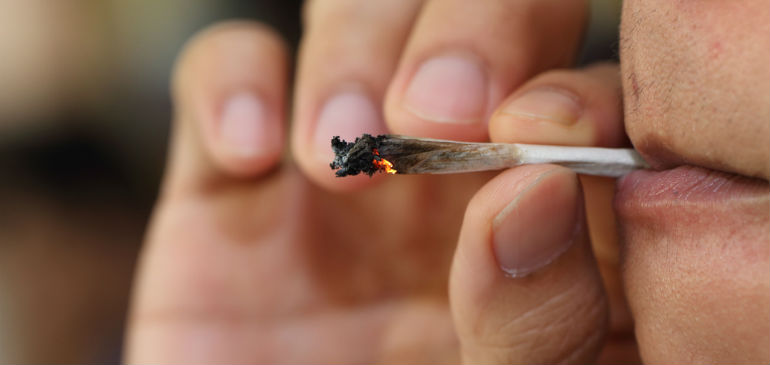
The criminalization of marijuana happened in 1956 when it was included in the Narcotics Control Act.
Cannabis Prohibition: An End at Last?
In less than a century, the U.S. went from legal, unrestricted use of marijuana and hemp to complete prohibition. Since then, the country has seen medical and recreational marijuana be legalized in dozens of states, as well as the reversal of the federal ban on hemp. Does this spell the beginning of the end for marijuana criminalization? Over the next few years, many believe that it’s likely that the cannabis prohibition pendulum will complete its swing back in the opposite direction. Only time can tell what will happen in the final chapter of marijuana prohibition history.
Category Pages:
- Cannabis 101 - Cannabis information guide that ranges from cannabis culture to consumption methods.
- Cannabis and Cryptocurrency - A detailed guide to cryptocurrency and the cannabis industry.
- Cannabis and Driving - The effects of marijuana on driving; cannabis and professional drivers.
- Cannabis and Gaming - Marijuana's effect video game performance and why top gaming organizations are banning it.
- Cannabis and Parenting - A guide to the challenges parents face teaching kids about cannabis and navigating their own use while remaining responsible parents.
- Cannabis Decarboxylation - What decarboxylation does, as well as choosing the best decarb methods.
- Cannabis Facts - Fascinating info about cannabis history, facts about medical marijuana, and more.
- Cannabis Home Decor - A guide to chic and sophisticated 420 decoration ideas.
- Cannabis Prohibition - (CURRENT PAGE)
- Cannabis Tea - A guide to marijuana tea effects, its benefits, and how to make THC and CBD tea.
- Cannabis Technology - An overview of the ways marijuana technology has changed the cannabis industry.
- Cannabis Terpenes - A 101 guide to the uses, medical benefits, and research on marijuana terpenes.
- Cannabis Tourism - A guide to marijuana tourism in places with legal cannabis around the world.
- Federal Marijuana Legalization - Who are the biggest players in the fight against federal marijuana legalization in the U.S.A.?
- History of Cannabis - A sweeping history of marijuana and hemp from ancient times into the modern day.
- What Is 420? - What does 420 mean? A guide to the symbolism and origin of 420, as well as 4/20 day celebrations around the world.
- Cannabinoids - Exploration of cannabinoids, their effects, and their health benefits.
- Cannabis Types - A guide to the different types of marijuana: sativa, indica, hybrids, hemp, and ruderalis.
- Concentrates & Extracts - An exploration of cannabis concentrates & extracts from BHO and beyond.
- Cannabis & Health - A guide to the many benefits of marijuana, including medical and general health uses.

 Author: John White
Author: John White